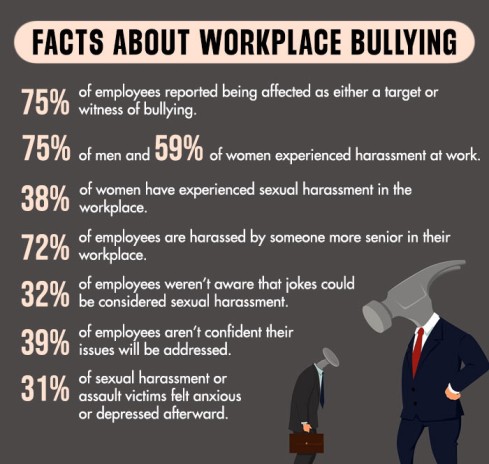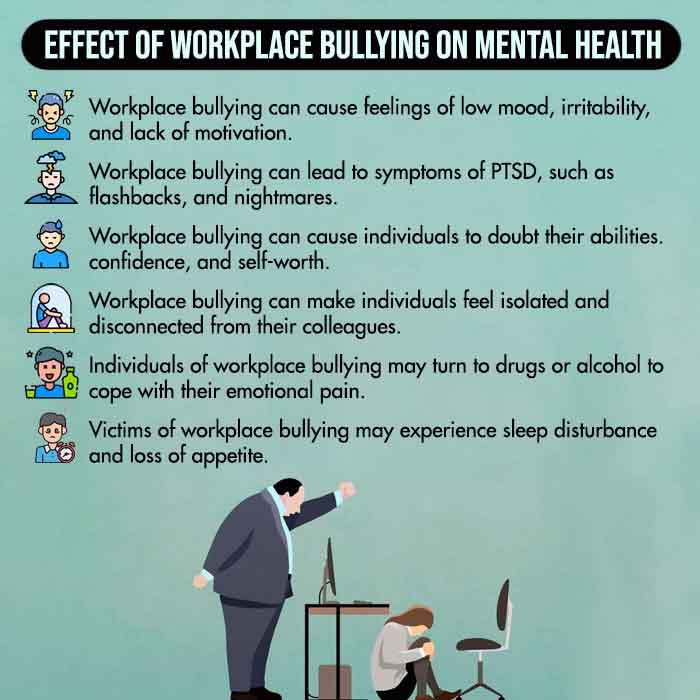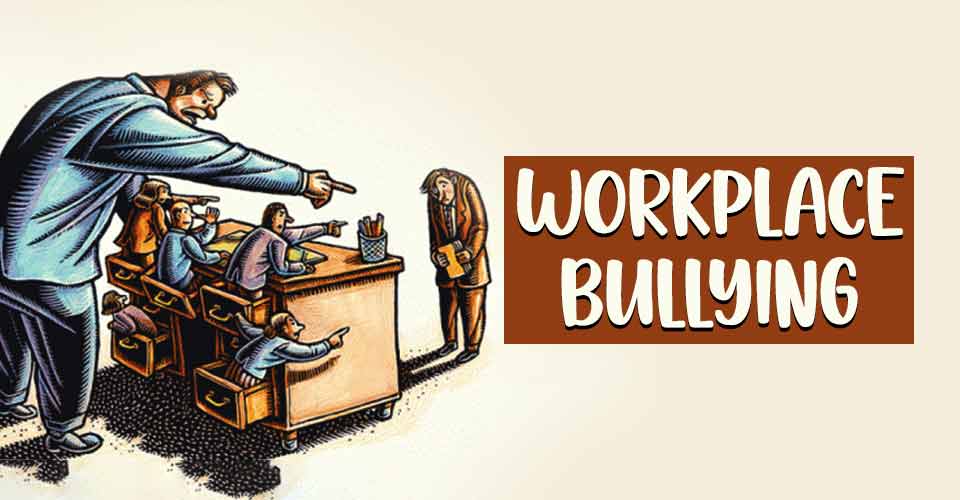Workplace bullying is a detrimental practice that involves an employee being subjected to repeated mistreatment by colleagues or superiors, causing severe negative impacts on mental and physical health, as well as job performance and career prospects. It can take many forms, including verbal abuse, physical intimidation, exclusion, and sabotaging someone’s work.
What Is Workplace Bullying?
Workplace bullying refers to the harmful pattern of repeated behavior directed towards an individual by one or more coworkers or managers that can persist over time, causing significant emotional and psychological harm and a toxic work environment, which negatively affects employee morale, productivity, and job satisfaction.
When employees are bullied, they may lose interest 1 Ariza-Montes, J. A., Muniz R, N. M., Leal-Rodríguez, A. L., & Leal-Millán, A. G. (2014). Workplace bullying among managers: a multifactorial perspective and understanding. International journal of environmental research and public health, 11(3), 2657–2682. https://doi.org/10.3390/ijerph110302657 in their work, which can lead to lower job satisfaction and an increased likelihood of being absent from work or leaving their job. This can be a problem for organizations because high levels of absenteeism 2 Sansone, R. A., & Sansone, L. A. (2015). Workplace bullying: a tale of adverse consequences. Innovations in clinical neuroscience, 12(1-2), 32–37. and staff turnover can be costly and disrupt business operations, which ultimately impact the organization’s financial bottom line.
Research shows that women 3 Rosander, M., Salin, D., Viita, L., & Blomberg, S. (2020). Gender Matters: Workplace Bullying, Gender, and Mental Health. Frontiers in psychology, 11, 560178. https://doi.org/10.3389/fpsyg.2020.560178 are more likely to be targets of workplace bullying than men, possibly due to stereotypes, discrimination, or assumptions of inferiority. Women may experience bullying differently from men, with gender-specific bullying such as sexual harassment being a common form.
Read More About Bullying Here
Examples Of Workplace Bullying
Here are some examples of workplace bullying:
- Verbal abuse, such as yelling, name-calling, and insults 4 Esfahani, A. N., & Shahbazi, G. (2014). Workplace bullying in nursing: The case of Azerbaijan province, Iran. Iranian journal of nursing and midwifery research, 19(4), 409–415. directed at an individual.
- Physical intimidation, including threatening behavior, invasion of personal space, or physical gestures 5 Al-Surimi, K., Al Omar, M., Alahmary, K., & Salam, M. (2020). Prevalence of Workplace Bullying and Its Associated Factors at a Multi-Regional Saudi Arabian Hospital: A Cross-Sectional Study. Risk management and healthcare policy, 13, 1905–1914. https://doi.org/10.2147/RMHP.S265127 .
- Excluding an individual from team meetings or social events, or refusing to communicate or work with them.
- Assigning unreasonable workloads 6 Al-Ghabeesh, S. H., & Qattom, H. (2019). Workplace bullying and its preventive measures and productivity among emergency department nurses. BMC health services research, 19(1), 445. https://doi.org/10.1186/s12913-019-4268-x or giving them an unrealistic deadline to complete a task.
- Monitoring an individual’s work closely, excessively criticizing their work, or not allowing them to make decisions on their own.
- Withholding important information or resources, or intentionally preventing an individual from completing tasks.

Types Of Workplace Bullying
There are several different types of workplace bullying, including:
1. Verbal Bullying
This type of bullying involves the use of words to hurt, intimidate, or belittle someone. Examples include humiliating 7 Board on Children, Y., Justice, C. on L. and, Medicine, I. of, & Council, N. R. (2014). Overview of Bullying and Victimization. In www.ncbi.nlm.nih.gov. National Academies Press (US). Available from: https://www.ncbi.nlm.nih.gov/books/NBK241577/ , shouting, or using offensive language.
2. Emotional Bullying
Emotional bullying involves deliberately causing emotional distress 8 Rivara, F., & Le Menestrel, S. (2016, September 14). Consequences of Bullying Behavior. Nih.gov; National Academies Press (US). Available from: https://www.ncbi.nlm.nih.gov/books/NBK390414/ to someone. Examples include insulting someone in front of others, spreading rumors, or threatening someone’s job security.
3. Sexual Harassment
Sexual harassment involves unwanted sexual advances 9 Acquadro Maran, D., Varetto, A., & Civilotti, C. (2022). Sexual Harassment in the Workplace: Consequences and Perceived Self-Efficacy in Women and Men Witnesses and Non-Witnesses. Behavioral sciences (Basel, Switzerland), 12(9), 326. https://doi.org/10.3390/bs12090326 or comments and can include physical or verbal behavior. Examples include inappropriate touching, making sexual comments or jokes, or displaying sexually explicit materials.
4. Regulation Bullying
This type of bullying involves the unnecessary enforcement 10 Sigursteinsdottir, H., & Karlsdottir, F. B. (2022). Does Social Support Matter in the Workplace? Social Support, Job Satisfaction, Bullying and Harassment in the Workplace during COVID-19. International journal of environmental research and public health, 19(8), 4724. https://doi.org/10.3390/ijerph19084724 of inappropriate rules made by an employer or employee in a position of power to make the target feel more powerless.
5. Discriminatory Bullying
Discriminatory bullying 11 Okechukwu, C. A., Souza, K., Davis, K. D., & de Castro, A. B. (2014). Discrimination, harassment, abuse, and bullying in the workplace: contribution of workplace injustice to occupational health disparities. American journal of industrial medicine, 57(5), 573–586. https://doi.org/10.1002/ajim.22221 involves targeting someone based on their race, gender, religion, or other personal characteristics. Examples include making derogatory comments or jokes or excluding someone based on their identity.
Early Warning Signs/Identifying Signs Of Workplace Bullying
It’s important to recognize the early warning signs 12 Lamb, J., Pepler, D. J., & Craig, W. (2009). Approach to bullying and victimization. Canadian family physician Medecin de famille canadien, 55(4), 356–360. of workplace bullying so that it can be addressed before it becomes more severe.
Here are some common workplace bullying signs:
1. Intimidation Tactics
Workplace bullies often use intimidation tactics to control their victims. These tactics may include yelling and using aggressive language 13 Smith, C. R., Palazzo, S. J., Grubb, P. L., & Gillespie, G. L. (2020). Standing up against workplace bullying behavior: Recommendations from newly licensed nurses. Journal of nursing education and practice, 10(7), 35. https://doi.org/10.5430/jnep.v10n7p35 .
2. Undermining Work
A workplace bully may intentionally undermine the victim’s work 14 Al-Ghabeesh, S. H., & Qattom, H. (2019). Workplace bullying and its preventive measures and productivity among emergency department nurses. BMC health services research, 19(1), 445. https://doi.org/10.1186/s12913-019-4268-x , such as by sabotaging projects or withholding important information.
3. Unreasonable Demands
Workplace bullies may make unreasonable demands 15 Steele, N. M., Rodgers, B., & Fogarty, G. J. (2020). The Relationships of Experiencing Workplace Bullying with Mental Health, Affective Commitment, and Job Satisfaction: Application of the Job Demands Control Model. International journal of environmental research and public health, 17(6), 2151. https://doi.org/10.3390/ijerph17062151 on their victims, such as expecting them to work long hours or complete tasks outside of their job description.
4. Personal Attacks
Workplace bullies may make personal attacks 16 Niedhammer, I., David, S., Degioanni, S., Drummond, A., Philip, P., Acquarone, D., Aicardi, F., André-Mazeaud, P., Arsento, M., Astier, R., Baille, H., Bajon-Thery, F., Barre, E., Basire, C., Battu, J. L., Baudry, S., Beatini, C., Beaud’huin, N., Becker, C., Bellezza, D., … Vital, N. (2009). Workplace bullying and sleep disturbances: findings from a large scale cross-sectional survey in the French working population. Sleep, 32(9), 1211–1219. https://doi.org/10.1093/sleep/32.9.1211 on their victims, such as criticizing their appearance, race, religion, or sexual orientation.
5. Blaming
Workplace bullies may blame their victims for problems that are not their fault or may try to make them a scapegoat 17 Edmonson, C., & Zelonka, C. (2019). Our Own Worst Enemies: The Nurse Bullying Epidemic. Nursing administration quarterly, 43(3), 274–279. https://doi.org/10.1097/NAQ.0000000000000353 for mistakes made by the bully or others.
6. Isolation
Workplace bullies often try to isolate 18 Emdad, R., Alipour, A., Hagberg, J., & Jensen, I. B. (2013). The impact of bystanding to workplace bullying on symptoms of depression among women and men in industry in Sweden: an empirical and theoretical longitudinal study. International archives of occupational and environmental health, 86(6), 709–716. https://doi.org/10.1007/s00420-012-0813-1 their victims from other coworkers. They may spread rumors or gossip about the victim or exclude them from social activities.
Why Do People Bully At Work?
There are many possible reasons why people may engage in bullying behavior at work. Here are some common factors 19 Feijó, F. R., Gräf, D. D., Pearce, N., & Fassa, A. G. (2019). Risk Factors for Workplace Bullying: A Systematic Review. International journal of environmental research and public health, 16(11), 1945. https://doi.org/10.3390/ijerph16111945 that may contribute to workplace bullying:
- Workplace bullies may use bullying as a way to feel more powerful and in control due to personal insecurities or low self-esteem 20 P. M., N., Jose, G., Vincent, M. T. P., & John, A. (2022). Workplace Bullying, Engagement and Employability: Moderating Role of Organization-Based Self-Esteem. Employee Responsibilities and Rights Journal, 1–16. Advance online publication. https://doi.org/10.1007/s10672-022-09420-7 .
- A culture of competition 21 Al-Ghabeesh, S. H., & Qattom, H. (2019). Workplace bullying and its preventive measures and productivity among emergency department nurses. BMC health services research, 19(1), 445. https://doi.org/10.1186/s12913-019-4268-x in some workplaces can increase the likelihood of bullying behavior.
- High workplace stress can result 22 Giorgi, G., Perminienė, M., Montani, F., Fiz-Perez, J., Mucci, N., & Arcangeli, G. (2016). Detrimental Effects of Workplace Bullying: Impediment of Self-Management Competence via Psychological Distress. Frontiers in psychology, 7, 60. https://doi.org/10.3389/fpsyg.2016.00060 in bullying behavior, as individuals may vent their frustration on others.
- Some individuals may have been bullied in the past 23 Fang, L., Hsiao, L. P., Fang, S. H., & Chen, B. C. (2020). Effects of assertiveness and psychosocial work condition on workplace bullying among nurses: A cross-sectional study. International journal of nursing practice, 26(6), e12806. https://doi.org/10.1111/ijn.12806 and are simply repeating this behavior to others.
- Unaddressed bullying behavior can escalate over time 24 Burr, H., Balducci, C., Conway, P. M., & Rose, U. (2022). Workplace Bullying and Long-Term Sickness Absence-A Five-Year Follow-Up Study of 2476 Employees Aged 31 to 60 Years in Germany. International journal of environmental research and public health, 19(12), 7193. https://doi.org/10.3390/ijerph19127193 and become more severe.
How Does Workplace Bullying Affect Your Mental and Physical Health
Workplace bullying can have a significant impact on an individual’s physical as well as mental health.
Here are some ways that workplace bullying can affect physical health:
1. Musculoskeletal Problems
Workplace bullying can lead to physical tension and muscle stiffness, which can cause musculoskeletal problems 25 Vignoli, M., Guglielmi, D., Balducci, C., & Bonfiglioli, R. (2015). Workplace Bullying as a Risk Factor for Musculoskeletal Disorders: The Mediating Role of Job-Related Psychological Strain. BioMed research international, 2015, 712642. https://doi.org/10.1155/2015/712642 such as back pain, neck pain, and headaches.
2. Cardiovascular Problems
Chronic stress caused by workplace bullying can increase the risk of cardiovascular problems 26 Kivimäki, M., Virtanen, M., Vartia, M., Elovainio, M., Vahtera, J., & Keltikangas-Järvinen, L. (2003). Workplace bullying and the risk of cardiovascular disease and depression. Occupational and environmental medicine, 60(10), 779–783. https://doi.org/10.1136/oem.60.10.779 such as heart disease and stroke.
3. Reduced Immune System Function
Workplace bullying can weaken the immune system 27 Rivara, F., & Le Menestrel, S. (2016, September 14). Consequences of Bullying Behavior. Nih.gov; National Academies Press (US). Available from: https://www.ncbi.nlm.nih.gov/books/NBK390414/ , making individuals more susceptible to illness and infection.
Here are some ways that workplace bullying can affect your mental health:
1. Increased Stress
Being a victim of workplace bullying can lead to increased levels of stress 28 Taniguchi, T., Takaki, J., Hirokawa, K., Fujii, Y., & Harano, K. (2016). Associations of workplace bullying and harassment with stress reactions: a two-year follow-up study. Industrial health, 54(2), 131–138. https://doi.org/10.2486/indhealth.2014-0206 , which can cause a range of physical health problems such as headaches, high blood pressure, and digestive issues.
Read More About Stress Here
2. Sleep Disturbances
Workplace bullying can cause sleep disturbances 29 Shakoor, S., M S Zavos, H., Gregory, A. M., & Ronald, A. (2021). The association between bullying-victimisation and sleep disturbances in adolescence: Evidence from a twin study. Journal of sleep research, 30(5), e13321. https://doi.org/10.1111/jsr.13321 , which may lead to disruption of the body’s biological clock, metabolism, and the sleep-wake cycle. In turn, this can affect the body’s homeostasis, or the ability to maintain a stable internal environment.
3. Depression and Anxiety
Workplace bullying can also cause mental health problems such as depression and anxiety 30 Rajalingam, D., Nymoen, I., Nyberg, H., Nielsen, M. B., Einarsen, S. V., & Gjerstad, J. (2021). Workplace bullying increases the risk of anxiety through a stress-induced β2-adrenergic receptor mechanism: a multisource study employing an animal model, cell culture experiments and human data. International archives of occupational and environmental health, 94(8), 1905–1915. https://doi.org/10.1007/s00420-021-01718-7 , which can have symptoms such as loss of job satisfaction, loneliness, or isolation from others.

Read More About Anxiety Here
Read More About Depression Here
How Does Bullying Affect The Workplace?
Bullying in the workplace can have numerous negative effects, which include:
- A hostile work environment.
- Toxic work culture 31 Rasool, S. F., Wang, M., Tang, M., Saeed, A., & Iqbal, J. (2021). How Toxic Workplace Environment Effects the Employee Engagement: The Mediating Role of Organizational Support and Employee Wellbeing. International journal of environmental research and public health, 18(5), 2294. https://doi.org/10.3390/ijerph18052294 , where employees feel unsupported, undervalued, and disengaged.
- Impact on the organization’s reputation, both internally and externally
- A negative perception of the organization 32 Rosander, M., Salin, D., & Blomberg, S. (2022). The last resort: Workplace bullying and the consequences of changing jobs. Scandinavian journal of psychology, 63(2), 124–135. https://doi.org/10.1111/sjop.12794 and difficulty in attracting and retaining quality employees.
- Potential legal and financial consequences 33 Soylu, S., & Sheehy-Skeffington, J. (2015). Asymmetric intergroup bullying: The enactment and maintenance of societal inequality at work. Human relations; studies towards the integration of the social sciences, 68(7), 1099–1129. https://doi.org/10.1177/0018726714552001 , such as legal fees, and other related expenses can be significant.
Coping With Workplace Bullying
If you are being bullied at work, it is important to take action to protect yourself. Here are some steps you can take:
1. Document the Bullying
Keep a record of any incidents of bullying, including what happened 34 Lamb, J., Pepler, D. J., & Craig, W. (2009). Approach to bullying and victimization. Canadian family physician Medecin de famille canadien, 55(4), 356–360. , when it happened, and who was involved.
2. Report the Bullying
Speak to your supervisor or HR (Human Resources) 35 Fareed, M., Ahmad, A., Salleh, S. S. M. M., Noor, W. S. W. M., & Isa, M. F. M. (2022). What Makes Human Resource Professionals Effective? An Exploratory Lesson From Techno-Based Telco Firms of a Developing Country. Frontiers in psychology, 13, 774165. https://doi.org/10.3389/fpsyg.2022.774165 representative about the bullying. Provide them with your documentation and ask for their help in resolving the issue.
3. Seek Support
Talk to someone you trust, such as a friend, family member, or therapist, about what you’re going through. You may also be able to get support from an employee assistance program 36 Richmond, M. K., Pampel, F. C., Wood, R. C., & Nunes, A. P. (2017). The impact of employee assistance services on workplace outcomes: Results of a prospective, quasi-experimental study. Journal of occupational health psychology, 22(2), 170–179. https://doi.org/10.1037/ocp0000018 (EAP) or a union.
4. Stand Up for Yourself
If you feel comfortable, speak up and assert your boundaries. Let the person know that such behavior is not acceptable.
5. Consider Your Options
If the bullying continues or your employer is unwilling or unable to help, you may need to consider other options, such as filing a complaint with a regulatory agency or seeking legal advice 37 Kim, H. S., & Sim, I. O. (2021). The Experience of Clinical Nurses after Korea’s Enactment of Workplace Anti-Bullying Legislation: A Phenomenological Study. International journal of environmental research and public health, 18(11), 5711. https://doi.org/10.3390/ijerph18115711 .
6. Practice Self-care
Take care of yourself both physically and emotionally. Make time for activities that you enjoy, such as exercise, reading, or spending time 38 Tsuno K. (2022). Do personal resilience, coping styles, and social support prevent future psychological distress when experiencing workplace bullying? Evidence from a 1-year prospective study. BMC psychology, 10(1), 310. https://doi.org/10.1186/s40359-022-00991-6 with loved ones.
Takeaway
Workplace bullying statistics reveal that employees who experience bullying are more likely to suffer from mental health issues, such as depression and anxiety, and have higher rates of absenteeism and presenteeism. It’s important for employers and employees to prevent workplace bullying, which requires implementing policies and procedures, providing employee training, and creating a culture of respect and inclusion.
At A Glance
- Workplace bullying is characterized by repeated abusive behavior at work.
- The effects of workplace bullying can be long-lasting and detrimental.
- Examples of workplace bullying include verbal abuse, spreading false information, and physical aggression.
- An early sign of workplace bullying may be increased tension, stress, or anxiety in the targeted employee.
- Workplace bullying and harassment can have serious negative impacts on an employee’s mental health and well-being.
- Knowing how to deal with workplace bullying is crucial for employees.
Frequently Asked Questions (FAQs)
1. What is The Purpose of An Anti-bullying Policy?
An anti-bullying policy establishes a safe and healthy work environment by outlining prohibited behaviors, consequences, and reporting procedures.
2. What is The Most Common Type of Harassment in The Workplace?
sexual harassment is the most common type of workplace harassment that creates a hostile work environment.
3. What are 3 Actions to Take If You’re Experiencing Workplace Harassment?
Take action by reporting it to your supervisor or HR representative, keeping a detailed record of the incidents, and seeking emotional support from trusted colleagues or professionals.
4. How Do I Report Bullying at Work?
To report bullying at work, check your company’s policy, and talk to your supervisor or HR to take some action.















